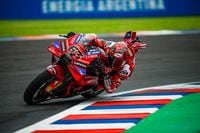Marc Márquez pulls into the pits after his crash at this year’s Circuit of The Americas Grand Prix. What’s the first thing the Ducati Lenovo pit crew does when the bike arrives back at the garage?
Do they:
A) Put the bike on a lift for inspection
B) Drain the fuel tank for safety reasons
C) Immediately tear down the bike for repairs
D) None of the above
If you answered “D,” you’ve got the right idea: The team’s first concern has nothing to do with the physical condition of Márquez’s million-dollar Ducati Desmosedici GP25. That’s because, believe it or not, the motorcycle’s onboard data is arguably its most valuable asset at any given race.
Yes, according to Gabriele Conti, electronics systems director at Ducati Corse, the first thing his team does after any Ducati Lenovo machine enters the garage is plug it into the computer to download its onboard data. So why all the fuss over all those ones and zeros?
According to Ducati Corse’s current research, the highly detailed data recorded out on the track during practice and qualifying can shave as much as three seconds off a rider’s time come race day. That’s roughly equivalent to a 300-meter head start at every outing, which may explain Ducati’s absolute dominance lately.
“Rider feedback used to be all we had to go on,” Conti says. “I’ve been working with Ducati since 2004. Back then, we only had two sensors on the bikes. Nowadays, we have around fifty.”
That’s 50 separate sensors on every bike, monitoring and logging everything from oil level and air pressure to suspension dynamics and tire wear. That last one is particularly important, as Conti says roughly 60% of the team’s effort is focused on tire performance alone.
The shift from analog to digital began in earnest around 2010, but as more and more data was collected out on the track, a new issue began to surface. Within a few years, teams were logging as much as 200 gigabytes of potentially race-changing data over the course of a weekend, but they had no way to process and analyze it in a useful time frame.
That’s when Ducati’s relationship with global technology giant Lenovo took on a new dimension.
Ducati’s partnership with Lenovo started back in 2018, but things really began picking up speed in 2020. Strict regulations due to COVID limited the number of people allowed on the track, and the ability to collect and analyze data remotely became a necessity.
Ducati’s response was to build what’s now referred to as the “Remote Garage,” a stand-alone wing at Ducati headquarters in Bologna whose sole purpose is to analyze live track data on race weekends.
The Remote Garage is powered by Lenovo’s latest and greatest computing and AI technology, and staffed with a rotating cast of some 50 employees who analyze data 24/7 during the races. Because the remote team can work through the night while the riders sleep, they’re able to identify potential performance gains from practice sessions that racers can implement in time for qualifying, sprints, and the main event.
Conti says in the early years, data wasn’t available until after the race was over, which isn’t much help if you want your rider on the podium every weekend. Now the Remote Garage can analyze and process data so quickly that even on a weekend like COTA, where changing weather essentially gave the team two very different sets of information, there’s still time to pull actionable insights from the data.
In addition to these “same day” improvements, the Remote Garage project has grown to implement data in other useful ways. For instance, all that detailed data gets fed into simulation algorithms, which the team uses to refine everything from the shape of their fairings to their engine-mapping and traction-control parameters.
Conti says predictive AI is also playing a major role in helping riders to find their limits. Before the digital era, crashing a motorcycle was essentially the only way to know precisely where its limits were. Now, Conti says machine learning models can tell riders where they need to slow down as well as where they can afford to push a little harder.
Despite the major advantage computing offers modern MotoGP teams, Conti admits there are limitations to what computing and electronics can accomplish.
For instance, because regulations require all MotoGP machines to share the same software and ECUs, there are shared limitations built into each bike around processing power. Teams are also required to share information on any sensors they use on their bikes, although whether competitors will have the time, budget, or inclination to copy them is another matter.
The usefulness of all the data Ducati Lenovo has amassed also has its limits. For instance, because it didn’t rain last year at the race in Austin, the team didn’t have any relevant data to leverage in the event of a wet race this year.
Tire compounds, track conditions, and individual components on the racebikes are subject to change year to year as well. Predictive modeling goes a long way here, but Conti says there’s still no substitute for apples-to-apples comparison.
Last but not least, this is racing we’re talking about, which means there’s no replacement for the raw talent behind the bars of every motorcycle on the grid. Granted, the most successful riders are those who adapt and learn to leverage their technological advantages, but at the end of the day, there’s no traction control for that front tire and no substitute for the sheer grit of riders like Pecco Bagnaia or Marc Márquez.
2025 MotoGP Point Standings
Á. Márquez - Ducati - 87
M. Márquez - Ducati - 86
F. Bagnaia - Ducati - 75
F. Morbidelli - Ducati - 55
F. Di Giannantonio - Ducati - 44



















/cloudfront-us-east-1.images.arcpublishing.com/octane/MUQLOVLL2ZDGFH25ILABNBXKTI.jpg)
/cloudfront-us-east-1.images.arcpublishing.com/octane/TNOU5DNE2BC57MFPMGN2EIDXAM.jpg)
/cloudfront-us-east-1.images.arcpublishing.com/octane/GTCXACQGJ5HAPDTGWUQKDEH44E.jpg)
/cloudfront-us-east-1.images.arcpublishing.com/octane/S35YGSEMEZB4BLTDJTSZPF4GLA.jpg)
/cloudfront-us-east-1.images.arcpublishing.com/octane/5UOT6HPX2JFMRJAX6EH45AR4MQ.jpg)
/cloudfront-us-east-1.images.arcpublishing.com/octane/OKWOJWAKP5EP3OACCRRWPCIX2Q.jpg)
/cloudfront-us-east-1.images.arcpublishing.com/octane/2WF3SCE3NFBQXLDNJM7KMXA45E.jpg)
/cloudfront-us-east-1.images.arcpublishing.com/octane/G4MG6OUCJNBSHIS2MVVOTPX65E.jpg)
/cloudfront-us-east-1.images.arcpublishing.com/octane/IIGGWFOTOJGB7DB6DGBXCCMTDY.jpg)
/cloudfront-us-east-1.images.arcpublishing.com/octane/QSTCM6AVEZA5JJBUXNIQ3DSOF4.jpg)
/cloudfront-us-east-1.images.arcpublishing.com/octane/U4I7G625B5DMLF2DVIJDFZVV6M.jpg)
/cloudfront-us-east-1.images.arcpublishing.com/octane/B6XD6LS6IVCQPIU6HXDJSM3FHY.jpg)
/cloudfront-us-east-1.images.arcpublishing.com/octane/ICL63FEDDRDTTMINYICCEYGMDA.jpg)
/cloudfront-us-east-1.images.arcpublishing.com/octane/FCGZHQXRBZFLBAPC5SDIQLVF4I.jpg)
/cloudfront-us-east-1.images.arcpublishing.com/octane/WNOB6LDOIFFHJKPSVIWDYUGOPM.jpg)

/cloudfront-us-east-1.images.arcpublishing.com/octane/X33NU3E525ECRHXLNUJN2FTRKI.jpg)
/cloudfront-us-east-1.images.arcpublishing.com/octane/6KKT5NNL2JAVBOXMZYS5ZO76YA.jpg)
/cloudfront-us-east-1.images.arcpublishing.com/octane/J5RKG5O455GMPGQRF2OG6LRT7A.jpg)
/cloudfront-us-east-1.images.arcpublishing.com/octane/GX2CIZKQVRH2TATDM26KFG2DAE.jpg)
/cloudfront-us-east-1.images.arcpublishing.com/octane/ZWIDYSAKQZHD5BHREMQILXJCGM.jpg)
/cloudfront-us-east-1.images.arcpublishing.com/octane/CYUHJZCTSJCH3MRAQEIKXK7SCQ.jpg)
/cloudfront-us-east-1.images.arcpublishing.com/octane/LKOFINY56FCXJCANJ5M7ZDQUBY.jpg)
/cloudfront-us-east-1.images.arcpublishing.com/octane/4NBPDACMWJH63JQYJVK3QRBDZI.jpg)